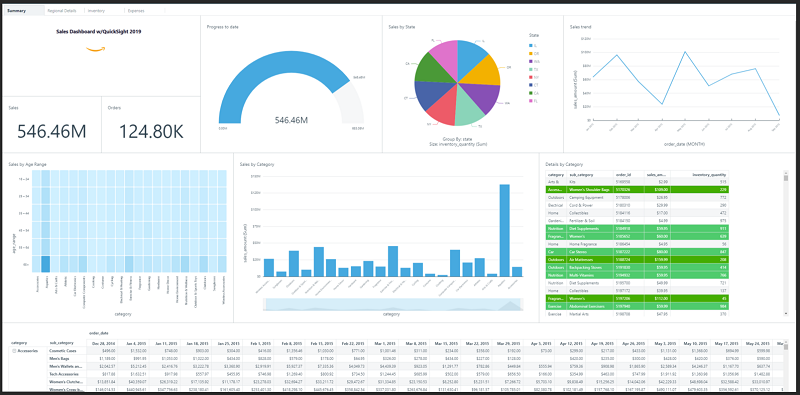AWS Big Data Blog
Tag: Amazon Quicksight
Highlight Critical Insights with Conditional Formatting in Amazon QuickSight
Amazon QuickSight now makes it easier for you to spot the highlights or low-lights in data through conditional formatting. With conditional formatting, you can specify customized text or background colors based on field values in the dataset, using solid or gradient colors. You can also display data values with the supported icons. Using color coding and […]
Evolve your analytics with Amazon QuickSight’s new APIs and theming capabilities
The Amazon QuickSight team is excited to announce the availability of Themes and more APIs! Themes for dashboards let you align the look and feel of Amazon QuickSight dashboards with your application’s branding or corporate themes. The new APIs added allow you to manage your Amazon QuickSight deployments programmatically, with support for dashboards, datasets, data sources, SPICE ingestion, and fine-grained access control over AWS resources. Together, they allow you to creatively tailor Amazon QuickSight to your audiences, whether you are using Amazon QuickSight to provide your users with an embedded analytics experience or for your corporate Business Intelligence (BI) needs. This post provides an overview of these new capabilities and details on getting started.
Enhancing dashboard interactivity with Amazon QuickSight Actions
Amazon QuickSight now offers enhanced dashboard interactivity capabilities through QuickSight Actions. QuickSight Actions provide advanced filtering capabilities through single point-and-click actions on dashboards. With Actions, you can link visuals within a dashboard so that selecting a dimensional point on one visual provides you with granular insights on the selected point on other visuals within your dashboard. Therefore, you can start with summaries and dive deep into details of your business metrics, all within the same dashboard sheet. You can define what visuals within your dashboard are interactive and how these interact with each other. As of this writing, QuickSight Actions lets you define two primary actions of interactivity: filter actions and URL actions. URL actions within Amazon QuickSight are not new, but the point of entry to create URL actions is now consolidated with Actions.
Amazon QuickSight announces the all-new QuickSight Mobile app
AWS is happy to announce the release of QuickSight Mobile for iOS and Android devices. This release is both a major update to the existing iOS app and the launch of a new Android application. The app enables you to securely get insights from your data from anywhere; favorite, browse, and interact with your dashboards; […]
Joining across data sources on Amazon QuickSight
Amazon QuickSight announced the launch of Cross Data Source Join, which allows you to connect to multiple data sources and join data across these sources in Amazon QuickSight directly to create data sets used to build dashboards. For example, you can join transactional data in Amazon Redshift that contains customer IDs with Salesforce tables that […]
Analyze Google Analytics data using Upsolver, Amazon Athena, and Amazon QuickSight
In this post, we present a solution for analyzing Google Analytics data using Amazon Athena. We’re including a reference architecture built on moving hit-level data from Google Analytics to Amazon S3, performing joins and enrichments, and visualizing the data using Amazon Athena and Amazon QuickSight. Upsolver is used for data lake automation and orchestration, enabling customers to get started quickly.
Federate Amazon QuickSight access with Okta
This post provides a step-by-step guide for configuring Okta as your IdP, and using IAM roles to enable single sign-on to Amazon QuickSight. It also shows how users and groups can be managed using the Amazon QuickSight API.
Create advanced insights using Level Aware Aggregations in Amazon QuickSight
Amazon QuickSight recently launched Level Aware Aggregations (LAA), which enables you to perform calculations on your data to derive advanced and meaningful insights. In this blog post, we go through examples of applying these calculations to a sample sales dataset so that you can start using these for your own needs.
Analyzing AWS WAF logs with Amazon ES, Amazon Athena, and Amazon QuickSight
This post presents a simple approach to aggregating AWS WAF logs into a central data lake repository, which lets teams better analyze and understand their organization’s security posture. I walk through the steps to aggregate regional AWS WAF logs into a dedicated S3 bucket. I follow that up by demonstrating how you can use Amazon ES to visualize the log data. I also present an option to offload and process historical data using AWS Glue ETL. With the data collected in one place, I finally show you how you can use Amazon Athena and Amazon QuickSight to query historical data and extract business insights.
Detect fraudulent calls using Amazon QuickSight ML insights
The financial impact of fraud in any industry is massive. According to the Financial Times article Fraud Costs Telecoms Industry $17bn a Year (paid subscription required), fraud costs the telecommunications industry $17 billion in lost revenues every year. Fraudsters constantly look for new technologies and devise new techniques. This changes fraud patterns and makes detection […]









